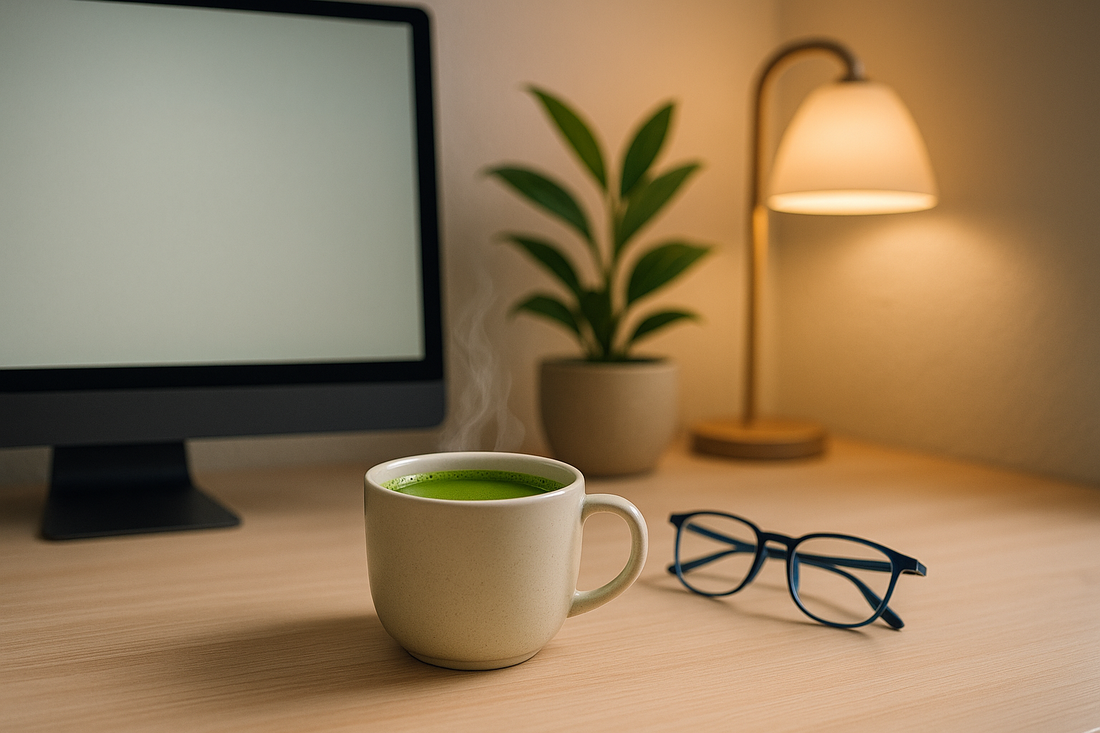
Screens are integral to modern work and play, but prolonged digital exposure can strain your eyes, cloud your mind and sap your energy. This article provides research‑backed strategies for mitigating digital fatigue, suggests movement and mindfulness practices and shows how matcha supports sustained focus without jitters.
Understand digital eye strain
Using computers, phones and tablets for hours at a time reduces how often we blink, causing the tear film on our eyes to evaporate more quickly. The result—digital eye strain—can lead to dry, irritated eyes, headaches, neck pain and blurred vision. Healthline reports that a 2020 study taught participants the 20‑20‑20 rule (taking a 20‑second break every 20 minutes to look at something 20 feet away) and found significant improvement in dry eye symptoms and tear film stabilityhealthline.com. Experts also advise positioning screens at arm’s length, reducing glare, adjusting brightness, blinking intentionally, setting reminder apps and using lubricating eye dropshealthline.com.
Move and rest regularly
Sitting for long periods is harmful even if you exercise before or after work. A study by Columbia University found that walking for five minutes every 30 minutes of sitting significantly lowered participants’ blood sugar and blood pressure, reducing blood sugar spikes by 58% and dropping systolic pressure by 4–5 mmHgcuimc.columbia.edu. The same study reported that these “exercise snacks” improved mood and reduced fatiguecuimc.columbia.edu. Another review of office exercises notes that brief bouts of movement throughout the day lower blood pressure and heart rate, boost productivity and elevate mood; vigorous activity under 10 minutes enhances memory and cognitionhingehealth.com. To counteract digital fatigue, schedule micro‑breaks: stand up, stretch, do a few squats or walk around the room every half hour. Pair these breaks with a sip of matcha to create a ritual your body will remember.
Harness matcha for sustained focus
When deadlines loom, many people reach for sugary energy drinks or extra coffees, only to crash later. Matcha offers a smoother alternative. The caffeine in matcha is released more gradually than coffee, and the presence of L‑theanine improves reaction time and working memory, increases alertness and reduces headaches and tirednesscureus.com. In one study, participants who drank matcha during a cognitive task completed more work and maintained better attention than those who consumed a caffeine‑only beveragecureus.com. This makes matcha a smart companion for long digital sessions: it keeps you alert without the anxious edge.
Craft your digital wellness ritual
-
Set a reminder: Use a timer or phone app to prompt the 20‑20‑20 rule every 20 minutes. When it goes off, look at something far away—preferably outside—and blink deliberately.
-
Move with purpose: Every half hour, stand up and walk for five minutes or do a quick yoga pose. Your blood sugar, blood pressure and mood will thank youcuimc.columbia.edu.
-
Sip mindfully: Keep a chilled House of Matcha oat latte at your desk. Use each break as an opportunity to take a small sip and savour the flavour. Pairing movement with matcha creates a habit loop that reinforces both behaviours.
-
Jot down a thought: After each break, write a sentence about how you’re feeling or one thing you’re grateful for. Journaling has been shown to reduce anxiety and boost well‑beingpositivepsychology.com.
-
Set boundaries: Define digital cut‑off times in the evening. Replace late‑night scrolling with reading, stretching or connecting with loved ones to support healthy sleep and relationships.
By combining these practices, you’ll protect your eyes, improve circulation, sustain mental clarity and integrate a gentle mindfulness ritual into your digital day.
References
-
A Healthline article explains that a 20‑20‑20 rule (20‑second break every 20 minutes to look at an object 20 feet away) significantly improves dry eye symptoms and tear film stabilityhealthline.com. It also recommends keeping screens at arm’s length, reducing glare, blinking often, adjusting brightness and using lubricating dropshealthline.com.
-
A randomized cross‑over study from Columbia University shows that walking five minutes every 30 minutes during prolonged sitting lowers blood sugar spikes by 58%, reduces systolic blood pressure by 4–5 mmHg, and improves mood and reduces fatiguecuimc.columbia.edu.
-
Research on brief “exercise snacks” finds that short bouts of activity throughout the day lower blood pressure and heart rate, boost productivity and mood, and that vigorous activity under 10 minutes enhances memory and cognitionhingehealth.com.
-
A systematic review demonstrates that caffeine combined with L‑theanine improves reaction time, working memory and cognitive accuracy, while reducing headaches and tirednesscureus.com. In extended tasks, participants who consumed matcha exhibited better attention and productivitycureus.com.
-
Studies on journaling reveal that expressive writing reduces anxiety and obsessive thinking, improves emotional regulation and self‑esteem, and even benefits physical healthpositivepsychology.com.